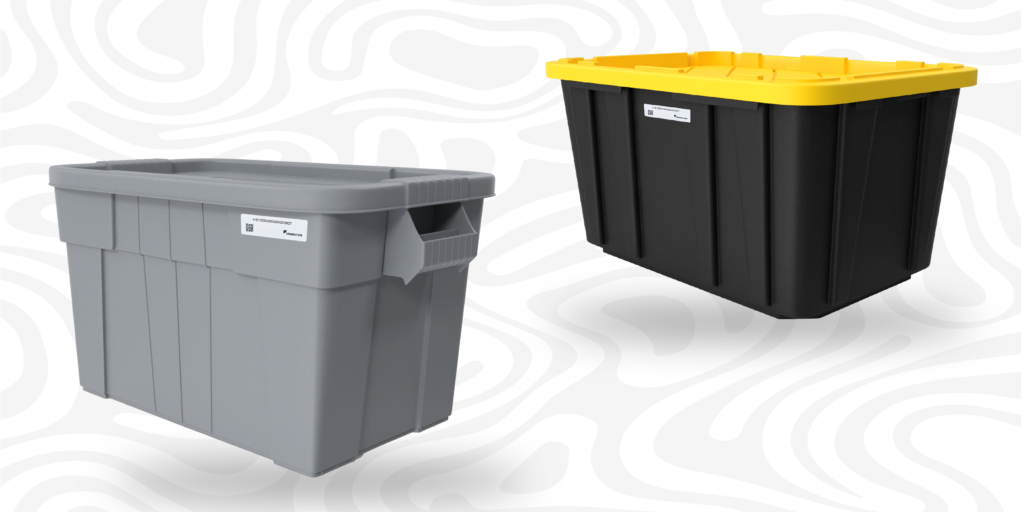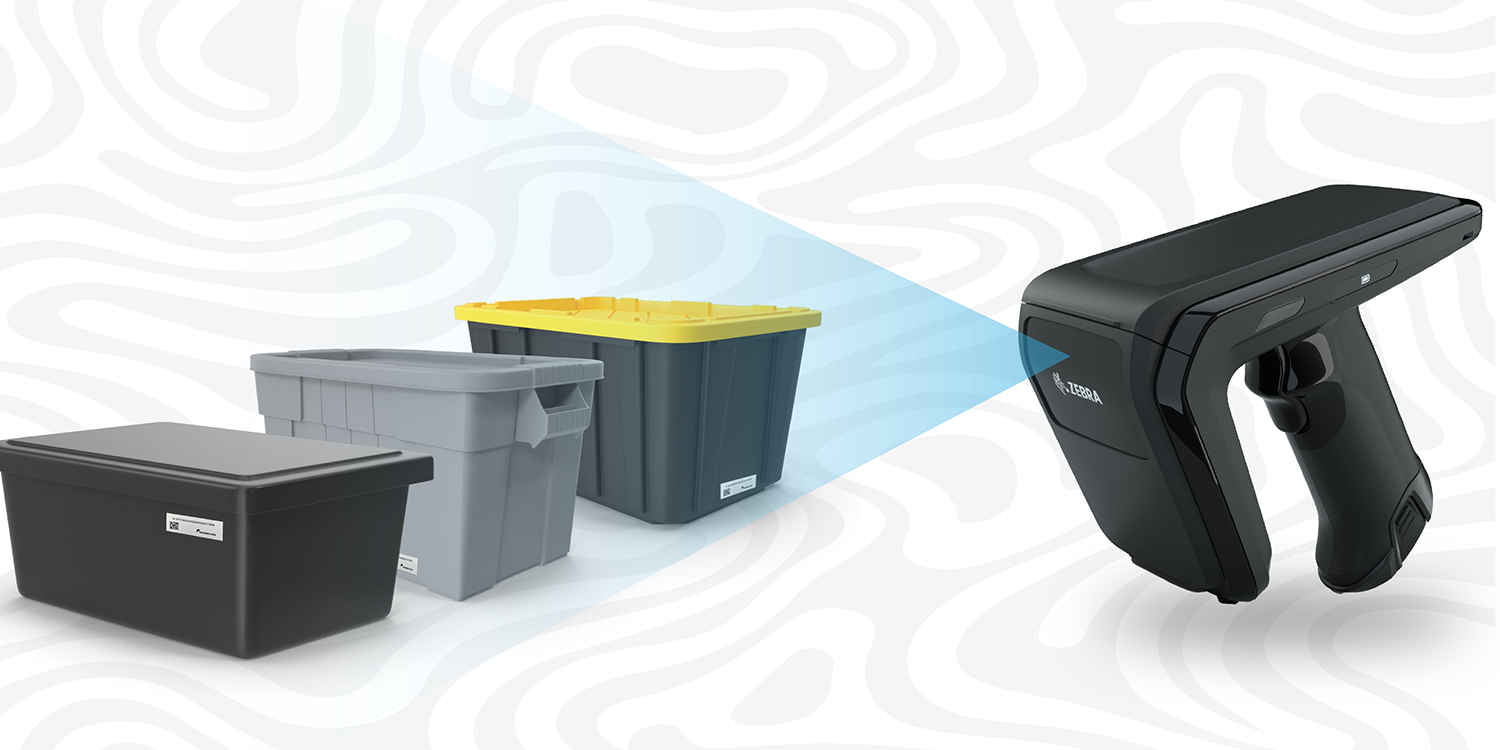In today’s fast-paced business environment, the ability to efficiently track and manage assets is crucial for maintaining operational efficiency and reducing costs. One technology that has gained prominence for its effectiveness in asset tracking is Radio Frequency Identification (RFID). This blog will delve into the details of how RFID can be used to track totes and other returnable assets.
Understanding RFID Technology
RFID, or Radio Frequency Identification, is a technology that uses radio waves to identify and track tags attached to objects. These tags contain electronically stored information that can be read by RFID readers from a distance, without the need for direct contact or line-of-sight scanning. RFID systems typically consist of three main components:
1. RFID Tags: These are small electronic devices attached to the assets. They come in two types:
- Passive Tags: These do not have their own power source and are activated by the electromagnetic energy transmitted by RFID readers.
- Active Tags: These have their own power source, allowing them to transmit signals continuously or at intervals.
2. RFID Readers: These devices emit radio waves and receive signals from RFID tags. They can be handheld or fixed, depending on the application.
3. RFID Software: The RFID software processes the data collected by the RFID readers, providing meaningful insights and enabling integration with other systems.
Implementing RFID technology for tracking totes and other returnable assets can significantly improve inventory management, reduce losses, and enhance operational efficiency. Following the outlined process, businesses can leverage RFID to achieve accurate and real-time asset tracking.

Tagging Assets
Select Appropriate RFID Tags
- Choose tags based on asset material, environment, and required read range.
- Ensure tags are durable and can withstand environmental conditions (e.g., temperature, moisture).
Tag Placement
- Attach RFID tags to a conspicuous and accessible location on each asset.
- Ensure tags are placed where they won’t be easily damaged or obscured.
Setting Up RFID Readers and Antennas
Fixed Readers
- Install fixed RFID readers at strategic points such as entry/exit points, loading docks, and storage areas.
- Ensure proper coverage and overlapping read zones to prevent missed reads.
Handheld Readers
- Utilize handheld RFID readers for inventory checks, audits, and mobile tracking.
- Equip staff with handheld readers for manual scanning in areas without fixed reader coverage.
Asset Registration
- Register or Create Part master and asset in the TagMatiks Asset Tracking Software with a unique identifier linked to its RFID tag.
- Record additional asset details such as type, owner, and maintenance schedule.
Regular Audits and Inspections
- Conduct regular audits to ensure all assets are accounted for and tags are functioning correctly.
- Inspect and replace damaged or malfunctioning RFID tags promptly.
Applications of RFID in Tracking Returnable Assets
1. Real-Time Location Tracking
- Warehouse Management: RFID tags attached to totes can be read by strategically placed RFID readers throughout the warehouse. This setup allows for real-time tracking of the movement and location of each tote, providing accurate inventory management and reducing the likelihood of misplaced or lost items.
- Logistics and Transportation: RFID can be used to track the location of returnable assets such as pallets, containers, and crates as they move through the supply chain. This ensures visibility and traceability at every stage of the journey.
2. Automated Check-In/Check-Out Processes
- Retail and Distribution: In environments where totes and other returnable assets are frequently moved in and out, RFID can automate the check-in and check-out processes. As assets pass through RFID gates or readers, their movements are automatically recorded, reducing the need for manual data entry and minimizing human error.
- Rental Services: Companies that rent out equipment, such as construction tools or medical devices, can use RFID to track the issuance and return of assets, ensuring accurate billing and reducing loss.
3. Inventory Management
- Asset Utilization: By providing real-time data on the location and status of returnable assets, RFID helps businesses optimize their usage. For example, if certain totes are frequently idle while others are overused, the company can redistribute assets to improve efficiency.
- Inventory Accuracy: RFID reduces the time spent on manual counting and increases inventory accuracy, ensuring that businesses have up-to-date information on their assets.
4. Maintenance and Lifecycle Management
- Preventive Maintenance: RFID tags can store information about the maintenance history of returnable assets. This data can be used to schedule timely maintenance, reducing the risk of asset failure and extending their lifespan.
- Lifecycle Tracking: By tracking the usage and condition of assets over time, businesses can make informed decisions about when to repair, retire, or replace them.
5. Loss Prevention and Security
- Theft Deterrence: RFID technology helps prevent the loss of returnable assets by providing real-time alerts if an asset moves out of a designated area. This is particularly useful in preventing theft and ensuring that assets are returned on time.
- Asset Recovery: In the event of loss or theft, RFID can assist in the recovery of assets by providing precise location data.
Benefits of Using RFID for Tracking Returnable Assets
1. Increased Accuracy and Efficiency
- Reduced Human Error: By automating data capture and entry, RFID significantly reduces the chances of human error in tracking and inventory management.
- Faster Processing: RFID allows for quick and efficient processing of large volumes of assets, improving operational efficiency.
2. Cost Savings
- Lower Replacement Costs: By preventing asset loss and optimizing asset utilization, RFID helps businesses save on the costs associated with replacing lost or damaged assets.
- Reduced Labor Costs: Automated tracking reduces the need for manual labor, leading to cost savings.
3. Enhanced Visibility and Control
- Real-Time Insights: RFID provides real-time visibility into asset movements, enabling better decision-making and improved operational planning.
- Improved Asset Management: Businesses can track the entire lifecycle of their assets, from acquisition to disposal, ensuring optimal utilization and maintenance.
4. Scalability and Flexibility
- Scalable Solutions: RFID systems can be easily scaled to accommodate the growing needs of a business, making them a long-term solution for asset tracking.
- Versatility: RFID can be used across various industries and applications, from retail and logistics to healthcare and manufacturing.
5. Improved Customer Satisfaction
- Timely Deliveries: Efficient tracking and management of returnable assets ensure timely deliveries and better service, leading to improved customer satisfaction.
- Accurate Billing: Automated check-in/check-out processes ensure accurate billing for rental services and other applications.
Real-World Case Studies
1. Retail Industry
- Scenario: A major retailer implemented RFID to track reusable totes used for transporting goods between distribution centers and stores.
- Results: The system provided real-time visibility into tote locations, reducing loss and improving turnaround times. The retailer saw a 20% reduction in lost totes and a significant improvement in inventory accuracy.
2. Manufacturing
- Scenario: A manufacturing company used RFID to track the movement of pallets and bins within their facility.
- Results: By automating the check-in/check-out process, they reduced the time spent on manual logging by 50% and improved overall asset utilization.
3. Healthcare
- Scenario: A hospital used RFID to track the usage and maintenance of medical equipment such as infusion pumps and wheelchairs.
- Results: The system ensured that equipment was available when needed, reduced downtime due to maintenance issues, and improved overall asset management.
Conclusion
RFID technology offers a robust solution for tracking totes and other returnable assets, providing real-time visibility, improving accuracy, and reducing operational costs. As industries continue to seek ways to enhance efficiency and reduce waste, RFID stands out as a powerful tool in the arsenal of asset management technologies. By embracing RFID, businesses can ensure that their returnable assets are effectively tracked, managed, and utilized to their fullest potential. Implementing RFID may require an initial investment, but the long-term benefits and cost savings it offers make it a worthwhile consideration for any business that relies on the efficient management of returnable assets. Whether in retail, logistics, manufacturing, or healthcare, RFID can transform how assets are tracked and managed, leading to greater efficiency, cost savings, and improved customer satisfaction.
